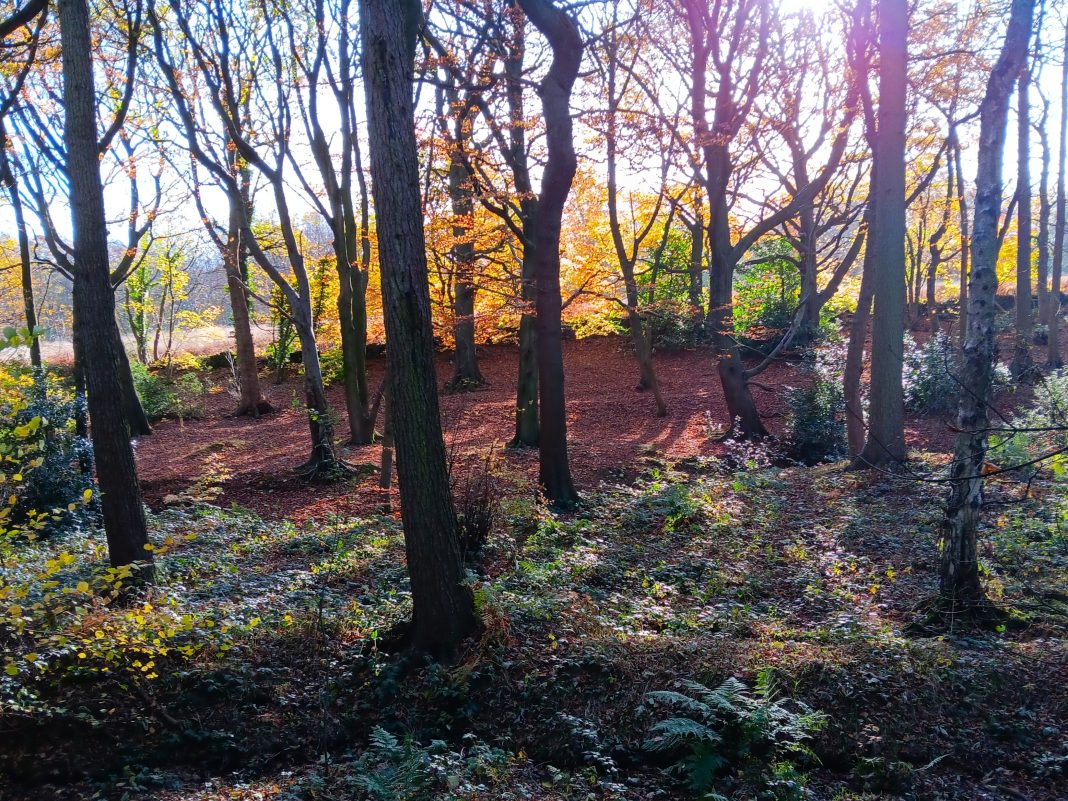Birdsedge to Clayton West. “Nobbut a trickle”
The day doesn’t start well. I have planned a short day’s walking as I have first to cross the Pennines. The usual bus to Preston, then trains to Huddersfield, followed by another bus journey to the walk’s start. It’s all a little complicated, but I had figured on the 8.50 train to Huddersfield, changing at Wigan and Manchester Victoria. This would have me on a bus to the start at lunchtime. While having my coffee at home, an email informs me that the train has been cancelled. Any later, I would struggle to connect with the bus, leaving me short of time in the afternoon; it’s getting dark by four. I need to catch an earlier train, but time is passing. I skip breakfast, run for a bus, and arrive at Preston station with two minutes to spare. The rest of the journey goes more or less to plan despite Northern Rail at Victoria verging on the chaotic.

A familiar figure outside Huddersfield Station.
When we arrive at Birdsedge, I’m the only one left on the bus, a few houses and an old spinning mill. 

There is a faded but encouraging waymark for The Dearne Way on the FP sign from the road. The path wanders through the trees, skirting the mill’s lodge. The infant Dearne River, feeding the dam, is barely a trickle, and yet, in the past, it spawned all the industries down its course. 

I’m on my way, and the weather is perfect, sun and blue sky, as promised. A few higher fields and walled lanes before I drop back down to the valley, here a woodland nature reserve. The autumn colours and the chirping birds are a joy. The path is hidden by the fallen leaves, and I swoosh through them like a young child. The water of the Dearne is barely visible. The way is proving more up and down than expected, but aren’t they all nowadays?






As I drop into Denby Dale, the many arched viaduct dominates the valley, header photo. The village came to prominence in the Industrial Revolution with mills and collieries. The railway arrived at the end of the C19th. 


I join the village Pie Trail on cobbled paths. They have a strange history of giant pie-making here. 





I’m content with a pot of tea in a friendly, high-street cafe. I learn how to pronounce Dearne – it’s Durn.


The route climbs out of the valley and traverses fields and woods with views over to the landmark Argiva transmission tower on Emley Moor. https://en.wikipedia.org/wiki/Emley_Moor_transmitting_station 
Somewhere up here, I walk into the grounds of Bagden Hall; I am staying in the hotel here tonight, but I see the opportunity of walking a little farther, thus reducing tomorrow’s mileage. I am trusting that I will be able to catch a bus back.


Down below is the village of Scissett, which, like everywhere around here, was previously dominated by worsted mills. I arrive at the main road by Spring Grove mill, which has survived, minus its chimney, manufacturing mats and carpets.

Spring Grove Mill Early C20th.
Paths lead through new housing estates and a long railway tunnel to meet with the Dearne again – time for a photo.

I broke my camera last week, so I am making do with my phone this trip; there will be no zooming. What with using it for navigation and pictures the battery is getting low, but sufficient to seek out a bus stop in Clayton West just in time for the X1 to arrive and take me back past Scissett to Nortonthorpe Mill. I find a sneaky, unofficial way into the grounds of Bagden Hall.


The hotel looks impressive with its extensive gardens, now a ‘Wedding Venue’ like many country hotels trying to survive. The price is reasonable and they give me a free upgrade. 
 Bagden Hall was originally built in the 1860s by Charles Norton, a wealthy mill owner who made his fortune running Nortonthorpe’s weaving mills in the valley, which supplied quality yarn to weavers for ‘fancy waistcoat goods’.
Bagden Hall was originally built in the 1860s by Charles Norton, a wealthy mill owner who made his fortune running Nortonthorpe’s weaving mills in the valley, which supplied quality yarn to weavers for ‘fancy waistcoat goods’.
It was quite a busy day in one way and another.
***















